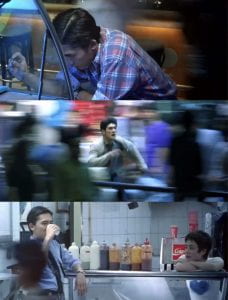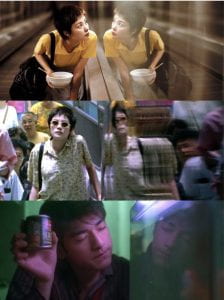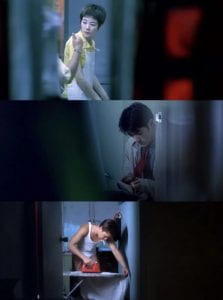1.
As a producer and a student, for the production of this short film, I think it is possible to achieve micro-budget. First because I am a student now. My shooting team can be classmates in the class, and we used to work together often. This shoot requires a cameraman, a sound recorder, a lighting engineer, and an actor. Our script is divided into four scenes, but three of them can be shoot at dusk. So for the shooting schedule, it can be completed in two days, and there is plenty of time to supplement the shooting. The only thing to pay attention to is the weather, avoid rainy weather. Shooting for two days, so need to provide meals. Because it is a micro-budget, meals may be simpler. Because the shooting location will be far from the city, you need to live there when shooting. In this way, the driving distance can also be reduced. Regarding the equipment problem, since I have a Canon camera, camera stabilizer and a DJI aerial camera. So in terms of equipment I don’t need to rent. I only need to pay the price of renting the lights.
For the location, because the shooting location is on a country road with a desert and a manor. Country Road is a public area, so it is free. As for the manor, I think renting a house nearby is fine. Just need to dress up to feel old. It may be more expensive to rent a house, because I don’t think it is easy to rent a house near the desert. But this budget must be much cheaper than rent manor.
Then there’s the house set, because the final scene is about being trapped in a room without a door. So what I came up with was that I needed two identical room sets, one with the door color blending in with the wall color. In this way, when the final shoot is taken, the effect of not being able to find the door can be shooting. It’s like being trapped in a confined space. Because the script as a whole is biased towards the thriller category, it will cost a bit on the room layout. Although some props I think can be borrowed or rented, such as an old child watchband, a child blue bicycle, a Teddy bear… But in order to highlight the weirdness, I will focus on the layout. Candles are consumables in this shoot, so prepare extras.
Although the costumes of the actors are required to be dark suits、tie. I think these costume actors have their own. So he can wear his own clothes. Because there will be lit candles at the filming site, the final actors’ performances will fluctuate greatly. For safety reasons, a Safety Officer is still required.
This short film will have some sound effects, such as the sound of the door opening. There are plenty of free sound effects to be found online, and I think that’s enough. In the end it will be spent on background music, I think one background music is enough. Or just need sound effects. Since the entire short film has no special effects, but needs to be stylized, an editor good with colors is needed.If the budget is not enough, I think the student of studying media can edit.
So to sum up, the production of this short film will cost a lot in editor, lighting and rent house. The biggest challenge is scene4 in the script – trapped in the room. Basically, micro-budget can be realized.
2.
The theme of this short film is to highlight a person’s state in different atmospheres, and the film ends with a little thriller plot. This script mainly tells the story of a man walking on a country road in the desert and finding an old manor. His mood changes as he sees the objects and photos in the room, and he is finally trapped in the room of the manor. A man’s state changes from exhaustion-surprise-panic-helplessness.
First of all, this script belongs to short film, so it doesn’t take long for the production schedule. Because this script takes two days to shoot enough time. You can arrange the house and set up the lights during the day on the first day. Towards dusk to shoot the three scenes ahead. The last time was all about shooting the last part. Because the whole plot belongs to the thriller category. Therefore, although the video production does not have special effects, it requires strong color impact and stylized editing. So there are two days of shooting, one day of rough cutting, two days of editing, one day of color adjustment, and the last day of reviewing and some part need change to edit. So this short film can be made in one week. In addition, the shooting time is only two days, the budget can have a lot left
Cinematically, the opening set-up shots of the scene will be grand. Shoot with DJI aerial camera, explain the background of the environment at that time, and then slowly approach the actor by shooting with camera stabilizer. Finally, the exhausted state of the actor at the time was captured through the mid shot and close up. Most of the first three scenes were shot in fixed positions. Use different shot.And the walking speed of the actor is also slow. These three scenes mainly introduce the state of the actor at that time, the background of the environment, and lead to the following important plots. In the fourth scene, which is mostly shot with the camera stabilizer, the movement of the lens is smooth. When a man wakes up like a dream, he needs to take a handheld shoot. The use of shaking camera shots reflects the nervousness and panic of men rushing around the room, looking for a way out. Finally, when he crouches down and uses the camera stabilizer again, start the shot from the man’s back. Move the camera slowly, changing the image from a mid-close up to a wide shot, until the image becomes dark and stop moving. Here I want the audience to feel the helplessness of the man at that time. Any equipment other than the two lights is my own, so I don’t need a lot of budget.
My opinion on post-editing is: I envisioned the film’s tone to be warm, with yellow as the main color outdoors, reflecting the hot weather at that time, and the men sweating constantly because of the heat and fatigue. The light source for indoor shooting simulates candle light, warm light dim tone. Here the man is in a dark house, drawn into this room by the faint light source. But here I also hope that the overall tone of this part is darker, which also echoes the later thriller plot. When a man enters a room, there should be a lot of scenery shot in the room. When he was looking for the door in a panic, He kept switching with scenery shot in the room. I hope it’s a spooky vibe. This is accompanied by a tense background music. The overall film has very little about sound design.
There are several sound effects in this film. Only when entering the room, a dark background music is needed, and the music gradually becomes louder and stops suddenly when panicked. To highlight the front and back contrast. The sound effects are free, and there is also free background music.
In the end, it is proved that as a producer, for the production of this short film, I think it is possible to achieve micro-budget.
3.
For this exercise, my biggest challenge was planning the shooting of the fourth scene. Because there is one plot where the door is going to disappear. My first thought was very simple to use a green screen. Use a green screen in place of the door. Post-production as a wall. But it suddenly occurred to me that this green screen effect would look a little weird. And post-production Ae will be more difficult than Pr. If you want a beautiful after effect, you have to 3D model it. I think this requires a very high budget. So I thought of using two rooms, the same arrangement, and one of them had the door the same color as the wall. This will save more budget, and the final editing effect is no problem. Through this exercise, I think the biggest cost is location and music. Although there will be free music, you may not find a very suitable one. Therefore, the music part should be reserved in the budget. The second is location, so in my future short films, I have a new idea that the location of the entire script is the same. It’s best to happen at home, so that you can reduce the cost of the car and rent. It was easy for me to overlook the driving problem in previous exercises. This time, the location of script- anyone there is far away, so it is the first time to consider the fare problem. Overall, this exercise has given me more concrete plans for future short films.





